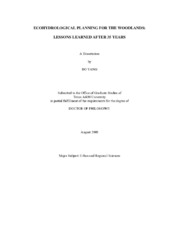| dc.description.abstract | The Woodlands, Texas, is a 27,000-acre new town created with Ian McHarg's
ecohydrological planning approach. The Woodlands is the best example of ecologically
based new town planning in the United States during the 1970s. The Woodlands
survived storms in excess of one-hundred-year levels in 1979 and 1994 with little
property damage, while Houston, 31 miles away, was severely flooded in both events.
For the past three decades, very few studies have been conducted to assess the
effectiveness of McHarg's planning approach. The objective of this study is three fold:
(1) To document McHarg's ecohydrological planning concepts, implementation and
unveil the barriers to continue his approach; (2) To compare flood mitigation
effectiveness of different drainage systems used in The Woodlands development; and (3)
To simulate "what if" land-use scenarios using different planning approaches.
Original development information is collected from published monographs, journal
articles, newspapers and designers' collections. Geographic Information System (GIS) parcel data are obtained from Montgomery County Appraisal District. Streamflow data
are acquired from the USGS website. Weather data are downloaded from the NOAA
website. Land use and land cover data are collected from various national datasets. Two
GIS hydrologic models--the Soil and Water Assessment Tool (SWAT) and the
Kinematic Runoff and Erosion model (KINEROS)--are used for watershed simulation.
The statistic analysis tool SPSS is used for correlation analysis.
Results show that McHarg's planning approach was followed in the early phases of
development (1974-1996) but was largely abandoned in the later phases when its
ownership was changed in 1997. McHarg's approach ceased to be implemented because
of the low public acceptance of ecohydrological planning strategies and the conflicts
between short-term investment return and long-term environmental stewardship. In
addition, comparative study shows that the early phases of development responded to
rainfall similarly to its pre-development forest conditions. However, the later phases
generated runoff volumes three times greater than the early phases.
Therefore, McHarg's ecohydrological planning approach demonstrates flood
mitigation effectiveness that is superior to the conventional approach. Finally, using soil
permeability to coordinate development density and land use presents a viable solution
for mitigating environmental impacts from a stormwater perspective. | en |


